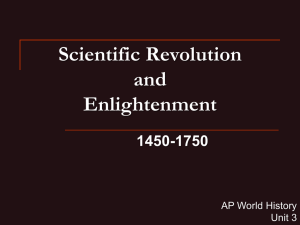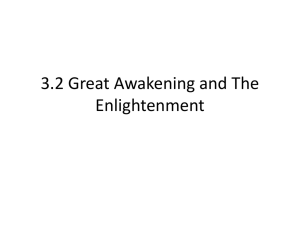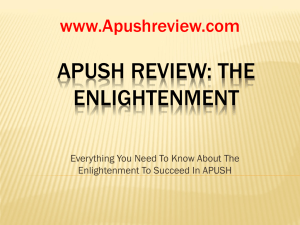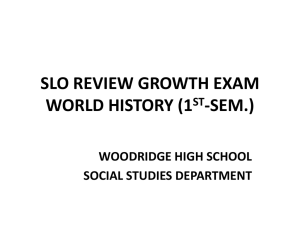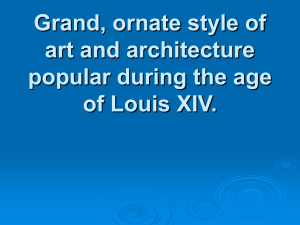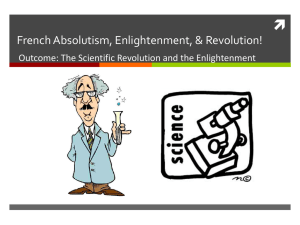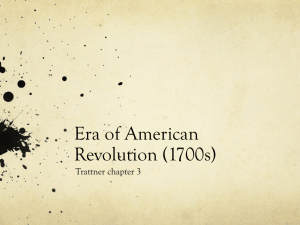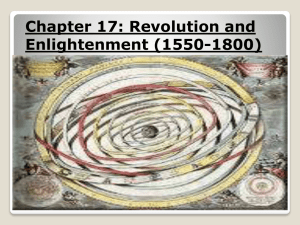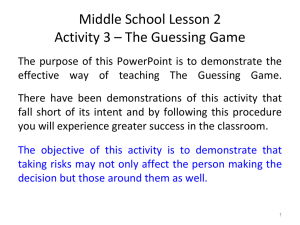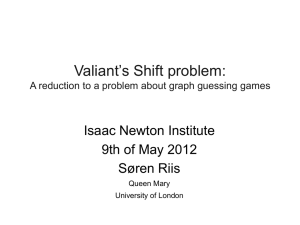OGT REVIEW SOCIAL STUDIES SESSIONS WITH MS. ESTRIGHT
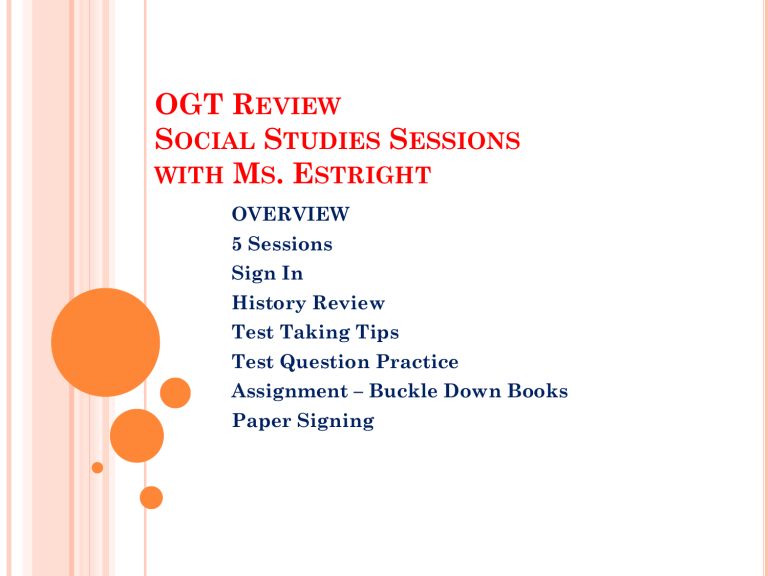
OGT R EVIEW
S OCIAL S TUDIES S ESSIONS
WITH M S . E STRIGHT
OVERVIEW
5 Sessions
Sign In
History Review
Test Taking Tips
Test Question Practice
Assignment – Buckle Down Books
Paper Signing
W HAT ARE YOUR AREAS OF W EAKNESS ?
It’s important to be able to identify what you know…
It’s important to be able to identify what you know you don’t know…
Take a moment to identify those two areas.
HISTORY REVIEW –
E MPIRES TO N ATION S TATES
In our lifetimes we are only familiar with nationstates – countries.
For 1000s of years prior to Industrialization, lands were governed as Empires and typically were ruled by monarchs.
HISTORY REVIEW –
R EVOLUTION
During the 1700s, people in these lands started to want independence and wanted rulers that looked out for their interests.
This brought about revolution.
Revolution was global. (Started in Europe and spread)
Nationalism was a major cause of unease – revolution.
Principle of Self-Determination applied when possible.
Led to the creation of nation-states – countries
HISTORY REVIEW –
N ATIONALISM
Nationalism is excessive pride in one’s NATION.
Nation is a group of people with common beliefs, heritage, language, etc.
Nationalism is a leading cause of WWI & WWII.
Nationalism vs. Patriotism
Nationalism – Pride in one’s NATION
Patriotism – Pride in one’s COUNTRY
For modern-day Americans, it’s often difficult to see the difference between the two… We are a country of immigrants and our Constitution affords everyone rights.
Before the time of Enlightenment, most people did not enjoy the benefits of self-determination.
HISTORY REVIEW –
E NLIGHTENMENT
Age of Reason
Movement of ideas; Thinkers believed that people had the right to form their own opinions about issues such as religion , nature, & art.
Revolutionaries began fights for freedom on 3 different continents – Europe, North America
(U.S), and South America (Latin American countries)
Renewed interest in Renaissance ideas – Interest in science (Started relating it to politics & government)
Scientific Method
Nicolaus Copernicus, Galilieo Galilei, Isaac Newton
HISTORY REVIEW –
E NLIGHTENMENT
The writings of the Enlightenment philosophers had a serious impact on people in Europe and the
Americas.
Unhappy with life under the rule of kings & queens, revolutionaries on both sides of the
Atlantic were excited by Enlightenment ideas.
The American Revolution, the French Revolution and the Latin American wars for independence were all influenced by Enlightenment thinking.
HISTORY REVIEW –
E NLIGHTENMENT
You can find the inspiration for the American,
French, & Latin American revolutions in the works of several key Enlightenment writers
Thomas Hobbes
John Locke
Baron de Montesquieu
Jean-Jacques Rousseau
HISTORY REVIEW –
E NLIGHTENMENT
SUMMARY:
The European Enlightenment brought major changes to Western society.
Connections between Enlightenment ideas and revolutionary thought helped spark the American and French Revolutions.
The Enlightenment, the American Revolution, and the French Revolution influenced Latin American wars for independence.
TEST TAKING TIPS
Guessing is not guesswork
Guessing is a good idea on the OGT – unlike other standardized tests… There’s no penalty for a wrong answer.
Even if you have no idea, you still have a 20-25% chance of getting it right!
OGT intentionally writes deceptive answer choices that “look” right.
Test takers eliminate answer choices from the guessing pool based on a hunch or intuition. Simple but correct answers often get excluded, leaving 0% chance of being correct.
TEST TAKING TIPS
$5.00 Challenge
You only mark your “best guess” if you are willing to bet $5 on it.
You only eliminate choices from guessing if you are willing to bet $5 on it.
If you eliminate this many choices:
0 1 2 3
Chance of getting it correct 25% 33% 50% 100%
If you accidentally eliminate the right answer or go on a hunch for an incorrect answer, your chances drop to 0%.
$5.00 test is important – If you give up the safety of a pure guess, it had better be worth the risk.
Make sure whatever guess you make is truly random:
ALWAYS PICK THE FIRST ANSWER CHOICE AMONG
THOSE REMAINING.
TEST TAKING TIPS
Specific Guessing Techniques:
Slang – Scientific sounding answers are better than slang ones.
Example:
A) To compare the outcomes of the 2 different kids of treatment
B) Because some subjects insisted on getting one or the other of the treatments.
•
B is much less scientific and is incorrect, while choice A is a scientific analytical choice & is correct.
TEST TAKING TIPS
Specific Guessing Techniques
B)
Extreme Statements – Avoid wild answers that throw out highly controversial ideas that are proclaimed as established fact.
Example:
A) Bypass surgery should be discontinued completely.
Medication should be used instead of surgery for patients who have not ahs a heart attack if they suffer from mild chest pain and mild coronary artery blockage.
Choice A is a radical idea and is incorrect; B is a calm rational statement, does not make a definitive, uncompromising stance, uses the hedge word “if” for to provide wiggle room.
TEST TAKING TIPS
Specific Guessing Techniques
Similar Answer Choices – When you have 2 answer choices that are direct opposites, one of them is usually the correct answer.
Example
A)
B)
Paragraph 1 described the author’s reasoning about the influence of his childhood on his adult life.
Paragraph 2 described the author’s reasoning about the influence of his childhood on his adult life.
(These 2 answer choices are very similar and fall into the same family of answer choices.)
A Family of Answer Choices is when 2 or 3 answer choices are very similar. Often 2 opposites and one may show an equality.
TEST TAKING TIPS
Specific Guessing Techniques
A Family of Answer Choices is when 2 or 3 answer choices are very similar. Often 2 opposites and one may show an equality.
Example:
A) Operation I or Operation II can be conducted at equal cost.
B) Operation I would be less expensive than Operation
II.
C) Operation II would be less expensive than Operation
I.
D) Neither Operation I nor Operation II would be effective at preventing the spread of cancer.
TEST TAKING TIPS –
S PECIFIC G UESSING T ECHNIQUES
Example:
A) Operation I or Operation II can be conducted at equal cost.
B) Operation I would be less expensive than Operation II.
C) Operation II would be less expensive than Operation I.
D) Neither Operation I nor Operation II would be effective at preventing the spread of cancer.
Note how the first 3 choices are related. (They all ask about a cost comparison.)
Beware of immediately recognizing B & C as opposites and choosing 1 of those 2. Choice A is in the same family of questions and should be considered as well.
Choice D is NOT in the same family of questions.
It has nothing to do with cost and can be discounted in most cases.
TEST TAKING TIPS –
S PECIFIC G UESSING T ECHNIQUES
Hedging
When asked for a conclusion that may be drawn, look for “hedge” phrases – likely, may, can, will often, sometimes, etc., often, almost, mostly, usually, generally, rarely, sometimes.
Question writers insert these HEDGE PHRASES to cover every possibility.
Often an answer will be wrong simply because it leaves no other room for exception.
AVOID ANSWER CHOICES THAT HAVE
DEFINITIVE WORDS LIKE “EXACTLY” &
“ALWAYS.”
TEST TAKING TIPS –
S PECIFIC G UESSING T ECHNIQUES
SUMMARY:
Eliminate as many choices as you can by using the
$5.00 test. Use common guessing strategies to help in the elimination process, but only eliminate choices that pass the $5.00 test.
Among the remaining choices, only pick your “best guess” if it passes the $5.00 test.
Otherwise, guess randomly by picking the first remaining choice.
SESSON ONE ASSIGNMENT
In Buckle Down 9 – Read p. 5-16 and complete the questions on a separate sheet of paper.
In Buckle Down 9 – Read p. 17-20 (To refresh your memory for practice questions in the next session.)
In Buckle Down 10 – Read p. 4-14 (To refresh your memory for practice questions in the next session.)
Visit www.copley-fairlawn.org/estright
I’ll have the PowerPoints posted and assignments.
Please come prepared to each session. This is for your own benefit!
